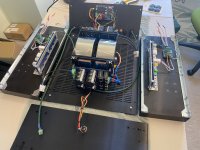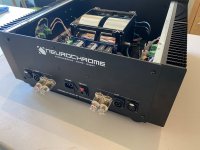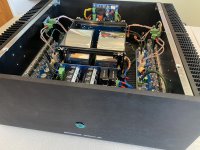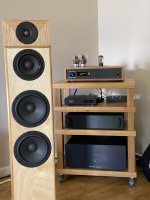You're very welcome. I'm glad you found the issue.BTW, I thought I would mention that I've been sharing a portion of my exploits here on the forum for everyone's entertainment and illumination. Behind the scenes, Tom has been responding to frequent emails, helping me each step of the way. I'm quite blown away by his attentiveness.
Yeah. The heat sinks on the Power-686 are connected to the cathodes of the rectifier diodes so you don't want a connection from the board-mounted heat sinks to the chassis. I should make a mention of that in the design doc.If I had been paying closer attention, I might have realized earlier that the screw head was encroaching on the heatsink.
Very well. I now recommend the SMPS800RE (±36 V) for the Modulus-686 for those who wish to have an SMPS-powered amp. Do note that the "800 W" of the SMPS800RE is "music power". It assumes a 10 dB crest factor. So the supply can really only deliver about 250 W continuously. Therefore, I recommend that you use one SMPS800RE per channel if you're planning to drive 4 Ω speakers. With 8 Ω speakers you can get away with one SMPS800RE in a stereo amp.How did the "2x Connex SMPS800RE (±36 V)" SMPS's work out ?
Those aiming for the Safe-n-Sane power levels should still use the Mean Well RPS-400-27(-C). Two are needed for a stereo amp.
See more here: https://neurochrome.com/pages/choosing-your-amp
Tom
Could you fit two of those SMPS800RE power supplies and two Modulus-686 boards within a Dissipante 4U/300mm case?You're very welcome. I'm glad you found the issue.
Yeah. The heat sinks on the Power-686 are connected to the cathodes of the rectifier diodes so you don't want a connection from the board-mounted heat sinks to the chassis. I should make a mention of that in the design doc.
Very well. I now recommend the SMPS800RE (±36 V) for the Modulus-686 for those who wish to have an SMPS-powered amp. Do note that the "800 W" of the SMPS800RE is "music power". It assumes a 10 dB crest factor. So the supply can really only deliver about 250 W continuously. Therefore, I recommend that you use one SMPS800RE per channel if you're planning to drive 4 Ω speakers. With 8 Ω speakers you can get away with one SMPS800RE in a stereo amp.
Those aiming for the Safe-n-Sane power levels should still use the Mean Well RPS-400-27(-C). Two are needed for a stereo amp.
See more here: https://neurochrome.com/pages/choosing-your-amp
Tom
Hi Walter,Hi Guys,
I was reading some of your recent posts and have decided to share some of my experience building my first Modulus-686. I will add the link to my google album as I didn't want to clutter this page with so many images. If you are interested in my build you can take a look here Modulus-686 - Google Photos
As you can see in the pictures I have decided to mount the amplifier modules diagonally and also centered between two heat sinks. This way I was able to drill and tap the holes right in between the fins and also achieve even distribution of heat dissipation. I have tested the temperature on all 4 heat sinks after 2 hours of driving the amp at high load and the temperature was even at around 63-65°C across all of them. This setup works very well for me and I'm very happy with the end result. Once all of my components were delivered it took me 2 weekends to finish this build. It was very easy and very satisfying project. Tom was very helpful to answer my questions and to select the right components for my build.
My listening impression is very positive. No audible noise or any type of distortion after hours of critical listening. For those that are interested in some "numbers" I can probably follow up in a few weeks posting my measurement results once I have a chance of finishing building my Autoranger MK II from linear audio.
I'm currently waiting on my second order from Modushop and would like to build the second matching mod686. Two of them will be driving my pair of bi amped Audio Artistry CBT36K Line Array. Can't wait to listen to the end result...
Please let me know your thoughts or any improvements you think I can make in my next build.
Regards,
Walter
I am about to build my 686 too and like your diagonal placement idea. I am having an issue of how to make the alignment however. Did you draw the fins locations on the FLAT side of the heatsink and then align the holes ? Do all holes line up perfectly ? Is there some kind of a trick you used to make the alignment easy ? Thanks
Well, I've got it put together:

It's been played only a few hours, so they're may be more burn-in required. As far as the performance goes, the first thing I noticed is that its gain isn't as much as my other amps (Avondale/Naim). For example, if I have the volume at 6 with my other amps, I need to turn it up to 8 with the Modulus-686. I can actually max out the volume on the Benchmark DAC1 (which also acts as pre) without it being too loud. I know that I can increase the gain by changing R19, but I'm not ready to take that step yet.
It's astonishingly clean and detailed--very controlled and beautiful. It sounds quite lovely!
Curiously, though, it's not as rhythmic as my Avondale builds. That may change over time.
It may be speaker synergy. So far I've auditioned it in the family room using the Royd RR3. These speakers are somewhat less engaging and "in your face" than the Ergo IX in my office. The Ergo forces you to get into the groove!!! (That's why the the RR3 is in the family room, as my wife doesn't like to be involuntarily dragged into the music.) Perhaps the amp will pair better with those. I won't have a chance to do that trial for a week or so.
It's been played only a few hours, so they're may be more burn-in required. As far as the performance goes, the first thing I noticed is that its gain isn't as much as my other amps (Avondale/Naim). For example, if I have the volume at 6 with my other amps, I need to turn it up to 8 with the Modulus-686. I can actually max out the volume on the Benchmark DAC1 (which also acts as pre) without it being too loud. I know that I can increase the gain by changing R19, but I'm not ready to take that step yet.
It's astonishingly clean and detailed--very controlled and beautiful. It sounds quite lovely!
Curiously, though, it's not as rhythmic as my Avondale builds. That may change over time.
It may be speaker synergy. So far I've auditioned it in the family room using the Royd RR3. These speakers are somewhat less engaging and "in your face" than the Ergo IX in my office. The Ergo forces you to get into the groove!!! (That's why the the RR3 is in the family room, as my wife doesn't like to be involuntarily dragged into the music.) Perhaps the amp will pair better with those. I won't have a chance to do that trial for a week or so.
Well, I've got it put together:
View attachment 1036866
It's been played only a few hours, so they're may be more burn-in required. As far as the performance goes, the first thing I noticed is that its gain isn't as much as my other amps (Avondale/Naim). For example, if I have the volume at 6 with my other amps, I need to turn it up to 8 with the Modulus-686. I can actually max out the volume on the Benchmark DAC1 (which also acts as pre) without it being too loud. I know that I can increase the gain by changing R19, but I'm not ready to take that step yet.
It's astonishingly clean and detailed--very controlled and beautiful. It sounds quite lovely!
Curiously, though, it's not as rhythmic as my Avondale builds. That may change over time.
It may be speaker synergy. So far I've auditioned it in the family room using the Royd RR3. These speakers are somewhat less engaging and "in your face" than the Very Ergo IX in my office. The Ergo forces you to get into the groove!!! (That's why the the RR3 is in the family room, as my wife doesn't like to be involuntarily dragged into the music.) Perhaps the amp will pair better with those. I won't have a chance to do that trial for a week or so.
Very nice! How big are the transformers—diameter and VA—and does the bottom plate support them well?
It's an AnTek AS-4222 - 400VA 22V, 5.1" d x 3.1" h. The bottom plate has no problem with this, although I do make it a point to keep them near the corners.Very nice! How big are the transformers—diameter and VA—and does the bottom plate support them well?
The feet in the front corners are quite near the transformers. The rear feet are about 2/3 of the way back, as the amp is quite front heavy. It also means I could put it on an open-back shelf intended for a 300mm deep components, and the feet would stay on the shelf.
Sometimes I use the extra inner Modushop mounting plate with my builds, but this one doesn't have it. It's probably a bit stronger with the plate, and keeps the screws and bolts hidden away. I'm not usually gazing at the bottom of my amplifiers, though.
Last edited:
Congrats on your build. I had a 2x6 LM3886 based amp and had to change it's gain jumper (increase) to match my other amps in an active biamped configuration.I had a bit of spare time, so I’ve hooked up the two transformers between the ISS and their Power-686 modules. With my mains at 124VAC, I’m getting ±32.5VDC from the 2x22VAC secondaries of the AnTek AS-4222. I choose the lower 22VAC, because I was concerned about my high mains, but I’ve never seen them hit 125VAC. Given the Modulus-686 can take ±36VDC, I could have probably gone for a transformer with 2x24VAC secondaries. I don’t expect to drive this amp to its max output, though, so ±32.5 should be sufficient.
I see different transformer companies rate their transformers at different input voltages [115, 117, 120, ...] which implies their spec'd output voltages vary with input voltages which I assume can be estimated using the ratio between the spec'd in and out values. I have read a lot of thread posts and have not seen anyone get 36V with the various transformers used including the recommended 2x24 or 2x25. I see Toroidy makes 2x[26,27,28,29,30, 31, ...] rated versions where other companies have fewer options jumping from 24 to 30 with nothing in between.
My mains consistently run at [120-121] VAC day or night (excluding rolling brown/blackouts).
Is there a formula to accurately predict the output voltages based on the mains typical voltage and other spec'd parameters short of actual trial and error ?
- Speaker load [4-8Ohms]: V
- Mains voltage [range]: W
- Transformer's spec'd input voltage: X
- Transformer's spec'd output voltage: Y
- Power 686 Bridge network: Z
Also, what are the possible input gains by changing R19. I have not found the possible gain range yet.
Thanks much.
Thanks.Congrats on your build. I had a 2x6 LM3886 based amp and had to change it's gain jumper (increase) to match my other amps in an active biamped configuration.
I see different transformer companies rate their transformers at different input voltages [115, 117, 120, ...] which implies their spec'd output voltages vary with input voltages which I assume can be estimated using the ratio between the spec'd in and out values. I have read a lot of thread posts and have not seen anyone get 36V with the various transformers used including the recommended 2x24 or 2x25. I see Toroidy makes 2x[26,27,28,29,30, 31, ...] rated versions where other companies have fewer options jumping from 24 to 30 with nothing in between.
My mains consistently run at [120-121] VAC day or night (excluding rolling brown/blackouts).
Is there a formula to accurately predict the output voltages based on the mains typical voltage and other spec'd parameters short of actual trial and error ?
- Speaker load [4-8Ohms]: V
- Mains voltage [range]: W
- Transformer's spec'd input voltage: X
- Transformer's spec'd output voltage: Y
- Power 686 Bridge network: Z
Also, what are the possible input gains by changing R19. I have not found the possible gain range yet.
Thanks much.
I think if you have all the parameters (as you've mentioned, plus transformer regulation, etc.), then perhaps. However, mains voltage is always going to vary, so it's a bit of a crap shoot.
On that point, I have a PS Audio PowerPlant 5, which can fix the output voltage at 120V. However, I use it for all my gear except for the power amp (Avondale NCC300 monos), because I find it strangles them a bit. I should mention that I have fairly clean mains with a dedicated run back to the breaker panel via 12AWG Romex.
My friend also has a P5, but his mains are terrible. Consequently, he uses the P5 to supply his amp (a very similar dual mono NCC300 amp that I built for him). His room is better suited than mine, and he's running Vandersteen 2ce Signatures, so his system sounds better than mine.
It's difficult to predict for sure which transformer voltage will be best. With this build it was too low: secondaries rated at 22VAC resulting in 29-32VDC. With another build it was too high: 42VAC resulting in 63VDC. Maybe one day I'll get it right.
Assuming that you want to find the maximum voltage in order to determine capacitor ratings and so forth, then you need to know an additional item: transformer regulation. If it was 5%, for example, then you would calculate 5% of the output voltage and add it on in addition to the % correction for the difference between the speed input voltage of the transformer and the highest expected outlet voltage.Is there a formula to accurately predict the output voltages based on the mains typical voltage and other spec'd parameters short of actual trial and error ?
- Speaker load [4-8Ohms]: V
- Mains voltage [range]: W
- Transformer's spec'd input voltage: X
- Transformer's spec'd output voltage: Y
- Power 686 Bridge network: Z
Any additional correction such as voltage drop due to rectifier diodes will reduce voltage so one can ignore them for determining design maximum voltage levels. Another correction would be for the apparent resistance of any line filter used.
Assuming that you want to find the maximum voltage in order to determine capacitor ratings and so forth, then you need to know an additional item: transformer regulation. If it was 5%, for example, then you would calculate 5% of the output voltage and add it on in addition to the % correction for the difference between the speed input voltage of the transformer and the highest expected outlet voltage.
Any additional correction such as voltage drop due to rectifier diodes will reduce voltage so one can ignore them for determining design maximum voltage levels. Another correction would be for the apparent resistance of any line filter used.
Thanks, that is helpful.
I was trying to comprehend the text data at the bottom and your explanation makes sense of it (transformer sags @ 1.9V from no load to full load) so @ 7.1% for this spec (less if considering normal output levels).
No load voltage would be 26.7V of this 25V rated transformer and slightly under 25V at full load with 120V mains.
I would assume a lower percentage is better, but is there a desired percentage range indicative of a good/stable/quality transformer ?
Kind of confusing that the top diagram indicates 115V mains and the bottom indicates 120V mains.
Last edited:
I just inserted the Modulus-686 into my office system. Initial impressions:
And at some point I have to open up the two Benchmark DACs and move those jumpers.
- The Ergo IX speakers in my office are more forward than the Royd RR3 in the family room. Consequently, they seem to be a better match for the 686. There is no lack of body, as there is with the RR3. Punch is also good. I'm still not sure if all the rhythm is there--still listening and deciding.
- The volume from the 686 (using the DAC2 balanced outputs) is actually louder than the Avondale NCC300 monos (using the RCAs). This seems to confirm that my Benchmark DAC1 in the family room has the internal XLR pad jumpers and they are set too low. For that matter, the DAC2 (which definitely has the jumpers) is set too high, as the volume is never above 9 o'clock.
- The 686 is better at realism and digging out the inner detail and timbre
- Dynamics, slam, and scale are very good.
- It might still be missing a bit of the fun/danceability, although it's not so obvious as it was in my other system.
And at some point I have to open up the two Benchmark DACs and move those jumpers.
686 build complete... I'm rather chuffed with it. Built using Tom's layout as available for download from the product page, but with dual-mono Toroidy Supremes in a 'Power cube' format using maker beam. No corners cut, and some unique features. Will post review / comparisons in due course.
Loving the dual colour LED on the font panel.
Thanks Tom for your support and products!





Loving the dual colour LED on the font panel.
Thanks Tom for your support and products!




Wow - nice build!686 build complete... I'm rather chuffed with it. Built using Tom's layout as available for download from the product page, but with dual-mono Toroidy Supremes in a 'Power cube' format using maker beam. No corners cut, and some unique features. Will post review / comparisons in due course.
Loving the dual colour LED on the font panel.
Thanks Tom for your support and products!
View attachment 1063483
View attachment 1063482
View attachment 1063484
View attachment 1063489
View attachment 1063490
That's a lovely build! Kudos!!!686 build complete... I'm rather chuffed with it. Built using Tom's layout as available for download from the product page, but with dual-mono Toroidy Supremes in a 'Power cube' format using maker beam. No corners cut, and some unique features. Will post review / comparisons in due course.
Loving the dual colour LED on the font panel.
Thanks Tom for your support and products!
View attachment 1063483
View attachment 1063482
View attachment 1063484
View attachment 1063489
View attachment 1063490
Thanks Fab, Troels 7751congratulations stretchneck, this amplifier build is simply amazing
you also seem to have a nice diy speaker as shown on the picture, is it Troels design?
Fab
- Home
- Vendor's Bazaar
- Modulus-686: 380W (4Ω); 220W (8Ω) Balanced Composite Power Amp with extremely low THD